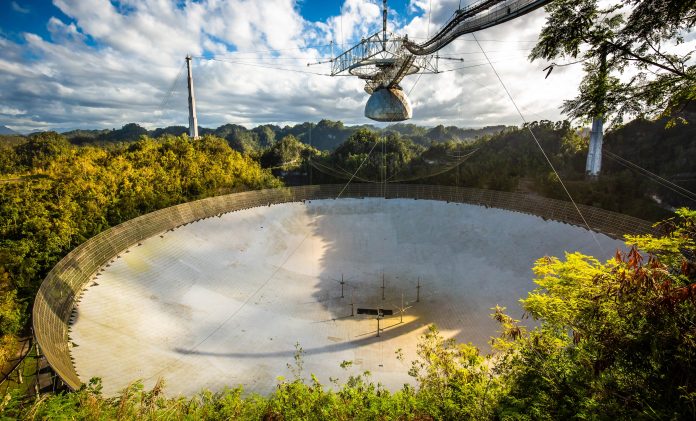In Puerto Rico, the Arecibo observatory has found potential “first hints” of low-frequency gravitational waves – signalling the movement of massive entities, like black holes or neuron stars
On 5 January, we reported that researchers based in Chile had come to a decision about the age of the universe – 13.77 billion years old, rounded up to a neat 14 billion years. The Hubble Constant is the measure of time that physicists used to decipher this, by understanding how quickly the universe is and was expanding.
The fabric of space-time is a constantly changing thing, shaped by the behaviour of gravity.
In a similarly dry and clear observatory based in Puerto Rico, astronomers are finding the first suggestions of low-frequency gravitational waves.
This research was conducted by the North American Nanohertz Observatory for Gravitational Waves, also known as NANOGrav.
The significance of finding these gravitational waves
The disturbances are known as gravitational waves, which ripple through space as a result of the movement of incredibly massive objects, such as black holes orbiting one another or the collision of neutron stars.
It’s important to understand these waves as they provide insight into the history of the cosmos and expand researchers’ knowledge of gravity past current limits of understanding.
Although the gravitational waves are stretching and squeezing the fabric of space-time, they don’t impact humans.
According to Joseph Simon, , a postdoctoral associate in the Center for Astrophysics and Space Astronomy at the University of Colorado Boulder, any changes in the relative distances between objects would change the height of a person by less than one one-hundredth the width of a human hair. For better or worse, you would not see yourself morphing in relation to gravitational changes pulling on the space-time fabric.
How did the team find these elusive waves?
The new findings made by NANOGrav researchers are unique because the astronomers found possible hints of low-frequency gravitational waves by using radio telescopes, since they cannot be detected by LIGO. Both frequencies are important for understanding the universe.
The researchers were able to detect possible hints of low-frequency gravitational waves by using the telescopes to study signals from pulsars – small, dense, rotating stars that send out pulses of radio waves at precise intervals toward Earth. This regularity make them useful in astronomical study, and they are often referred to as the universe’s timekeepers.
Gravitational waves can interrupt their regularity, causing deviations in pulsar signals arriving on Earth, thus indicating the position of the Earth has shifted slightly.
By studying the timing of the regular signals from many pulsars scattered over the sky at the same time, known as a “pulsar timing array,” NANOGrav was able to detect minute changes in the Earth’s position possibly due to gravitational waves stretching and shrinking space-time.
What will happen next?
“It is incredibly exciting to see such a strong signal emerge from the data,” Simon says.
“However, because the gravitational-wave signal we are searching for spans the entire duration of our observations, we need to carefully understand our noise. This leaves us in a very interesting place, where we can strongly rule out some known noise sources, but we cannot yet say whether the signal is indeed from gravitational waves. For that, we will need more data.”
Benetge Perera, a scientist at Arecibo Observatory, said: “A low-frequency gravitational wave detection would enhance our understanding of supermassive black hole binaries, galaxy evolution, and the universe.”
The US Government should build another observatory
Although the researchers used Arecibo data for the study, they are no longer able to make observations with it since the observatory sadly collapsed in December 2020, following broken cables in August and November.
Perera further commented: “Arecibo was very important as its timing data provided about 50 percent of NANOGrav’s sensitivity to gravitational waves. I want to ensure that the sensitive data we collected before Arecibo’s collapse has the highest possible scientific impact.”
“It was a truly horrible day when the telescope collapsed,” Simon commented.
“It feels like the loss of a good friend, and we are so saddened for our friends and colleagues in Puerto Rico. Going forward, we hope to increase the amount of time we use on the Green Bank Telescope to at least partially compensate for Arecibo’s loss. Another large collecting area radio telescope must be built in the U.S. soon if we want this research area to flourish.”











